Poppleton the hotel sustainable
HANNAH BRUDNEY



Why is sustainable design not more largely embraced by the public if its aim is to reduce or completely eliminate negative environmental impacts through thoughtful design? As knowledge of these negative impacts increases, our desire to do better for the environment should increase with it. In school, we learn about how interior design, good or bad, has a large impact on how we interact with spaces. It evokes emotions within its users, whether that’s intentional or not. Therefore, the health and wellbeing of its users becomes a key aspect when designing a space. How can we, as designers, accomplish that if the buildings we work within aren’t considering the health and wellbeing of the environment surrounding it?
From this, another question arises: How can we reverse the impacts our buildings are having on the environment? The answer is not tearing down the old and building new, rather it is in adaptive reuse. It’s looking at the needs of its community and environment. In this process, the carbon footprint of a building is lowered and subsequently, history is being preserved. Every building has a story to tell, whether in the architecture of the building or the human interaction that once happened within its walls. It’s time to tell those stories through design.
01 PROBLEM STATEMENT
02

01
02 How can the hospitality sector be shaped by design to be less wasteful?
03 How does sustainable design and adaptive reuse come together to promote materiality and historic preservation?
02 QUESTIONS
04

03 DESIGN INTENTION
The design intent is to tell a story through the interior environment. Woven within this story is the application of sustainable design that hints towards the need to design for the future. It aims to address the impacts the hotel industry has on the environment and teach guests to be more sustainable. This hotel design brings the past and the future together to create a unique experience for the present time.
06
WHAT CREATES...
...A GREAT HOTEL EXPERIENCE?
04 RESEARCH 08
5 MODES OF EXPERIENCE...
From the Gensler Experience Index
At the core of user experience is the user intention. Why are they here? The Gensler Experience Index breaks those Task, Social, Discovery, Entertain, and Aspiration. People don’t live in one singular mode, so designing spaces that allow for easy mode switching is the base for a great experience. The other factors of an experience include user expectations, interactions, and feel of the space. Together, these elements determine the user experience within a space.
WHY ARE THEY HERE?
WHAT MAKES A EXPERIENCE? GREAT
TASK SOCIAL DISCOVERY
USER INTENTION expectations snoitcaretni s ecap
ENTERTAIN ASPIRATION TASK SOCIAL DISCOVERY ENTERTAIN ASPIRATION
09
BEAUTY First Impression
WHAT CREATES...
...IN HOTEL SETTINGS
TASK MODE
The base for a great experience
new or ideas
INSPIRATION INTIMACY
mission
...A GREAT HOTEL EXPERIENCE?
TECHNOLOGY
with a new and better space
Hotels are the embodiment of our everything everywhere lifestyles because it supports a wide range of activities, whether guests are there for business or pleasure. The base of a great hotel experience is creating a great task mode experience. This means that the design and customer service meet guest needs by focusing on the cleanliness, safety, quality, and having a warm, welcoming staff. After that, the design features that matter most are beauty, comfort, authenticity, intimacy, inspiration, and the latest technology .
COMFORT AUTHENTICITY or
10
The Largest Impacts Hotels have on the Environment are...
Water and Energy Waste
LEED Certification
1. Sustainable Sites
3. Energy and Atmosphere
4. Materials and Resources
5. Indoor Environmental Quality
In order to prevent more damage to our environment, hotels need to take steps to reduce their consumption of water and energy and their production of waste. Conserving water is a big step for hotels. By simply installing low , hotels can reduce water
Other measures that can be taken are installing aerators in sinks and and asking guests to reuse sheets and towels during their stay to decrease laundry cycles. In order to conserve energy, hotels can use the process of
solar energy and install a green roof . These
connection with the HVAC, hotels can install Building Management Systems to control lighting, HVAC, and electrical throughout the building. In terms of lighting, hotels can replace light bulbs to CFLs , connect to occupancy sensors , and take advantage of daylighting . When it comes to lowering waste production, it’s all about reduce, reuse, and recycle . Use less disposable products, reuse when possible, and provide easy access to recycling bins.
219
1.9 84.7
11









WATER ENERGY WASTE GREEN ROOF CONSERVE HVAC REDUCE
REUSE RECYCE
LAUNDRY SOLAR LIGHT

21
Poppleton Landmark Building - Then

Poppleton Landmark Building - Now 06 SITE & BUILDING ANALYSIS 22
Douglas Street
Dodge Street
Farnam Street


10th Street
Harney Street
Howard Street
13th Street
Poppleton Landmark Building
1001 Farnam Street - Omaha, NE

a lawyer and politician from Omaha, and was designed by the architect, Henry Voss, in 1880. This three-story building lead to the shift from residential housing to a commericial downtown. True to the Italianate architecture of the late nineteenth century commercial buildings, it is divided into three equal bays that project past the front facade. Additionally, this brick building has sharp, angular cast-iron details with segmental arches found on the third story windows. The site is located across from the two
America Park. It is easily accessible by foot, public transit, or car and is a quick drive from the airport. It is surrounded by several Creighton University.
24



Poppleton Landmark Building 26
WHO IS MY USER?
07
28
USER PROFILE
BUSINESS LEISURE
This individual is visiting on business matters. They are here to get the job done but appreciate having time away from home. They take advantage of many amenities the hotel has to offer: gym, bar, room service, restaurant, etc.
This individual is here on vacation. They are want to explore what the city has to offer and are looking for an overall enjoyable experience. They appreciate the close proximity of other amenities in the area.
29
WORKER LOCAL
This individual works here. They spend their shifts keeping guests happy. This individual knows a lot about the close by amenities to tell guests about. They have a warm and welcoming demeanor about them.
This individual lives nearby and appreciates the public amenities the hotel has to offer. They stop by after work for happy hour with friends. This individual is all about the social experience provided.
30

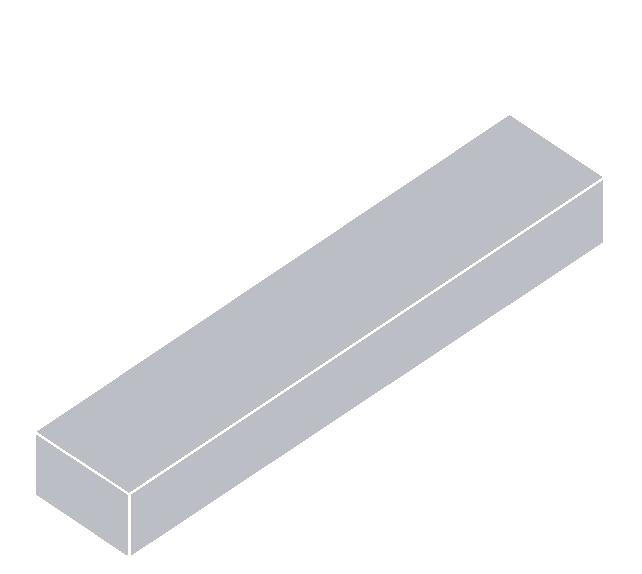


SQFT
08 SPATIAL PROGRAM 34
BUILDING PROGRAM
20, 796 SQFT
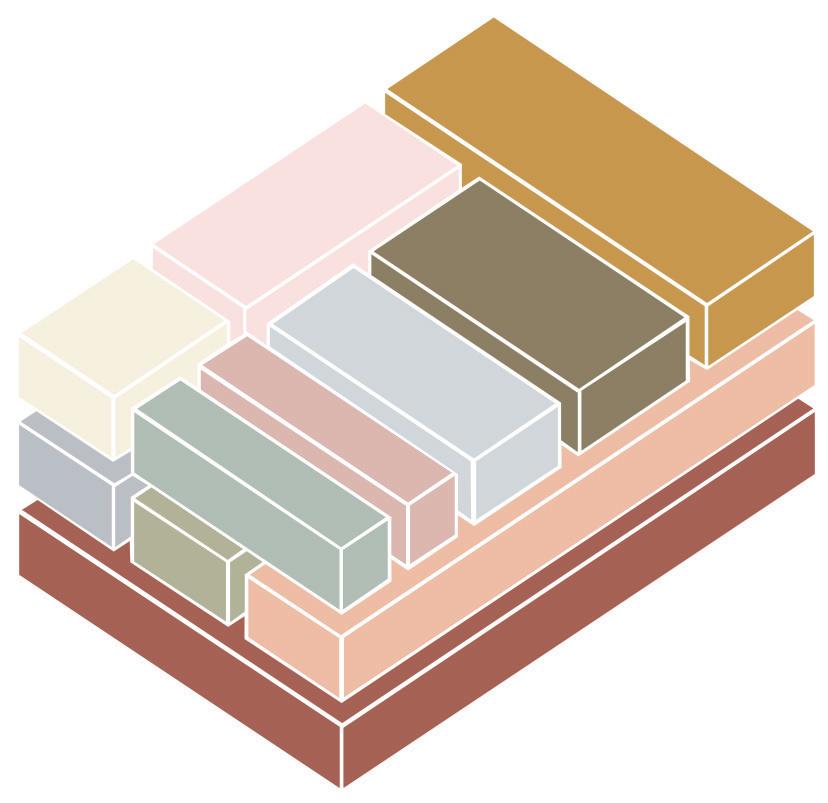
37
Luggage Storage
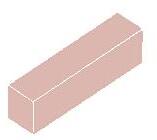


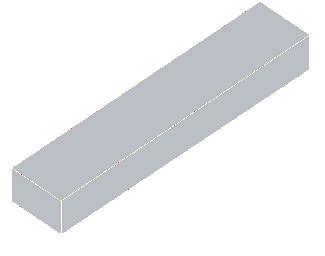
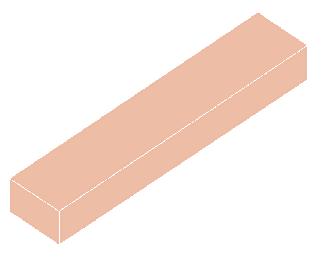

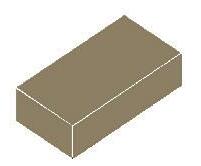
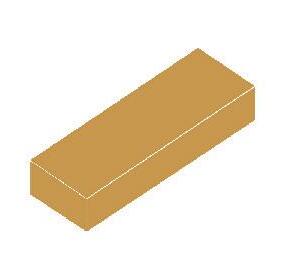
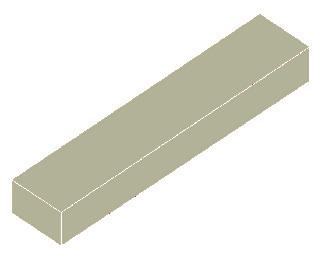
Conference Room
Public Restrooms
Fitness Center
Green Roof


Staff Offices
Ballroom
Restaurant & Bar
Guest Room
Lobby
Cafe
38

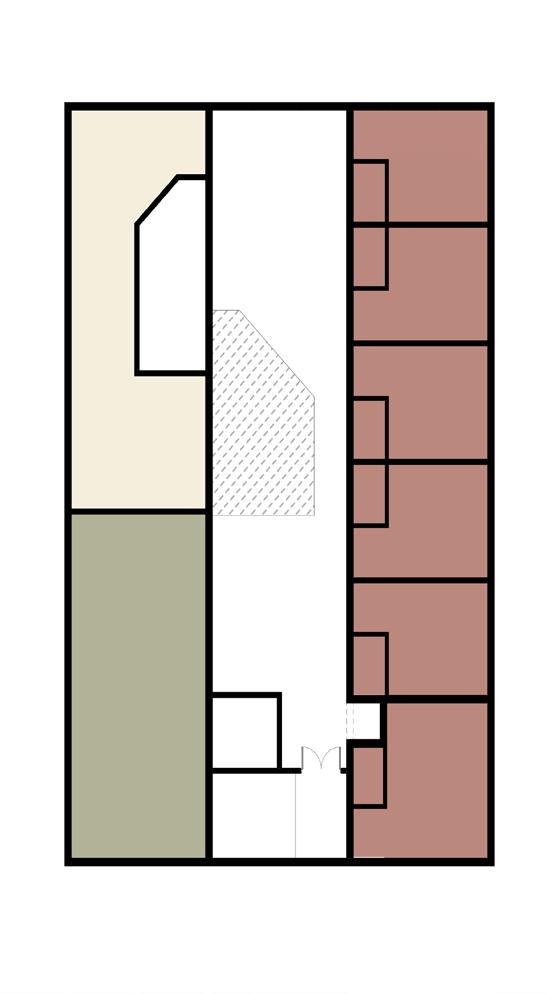



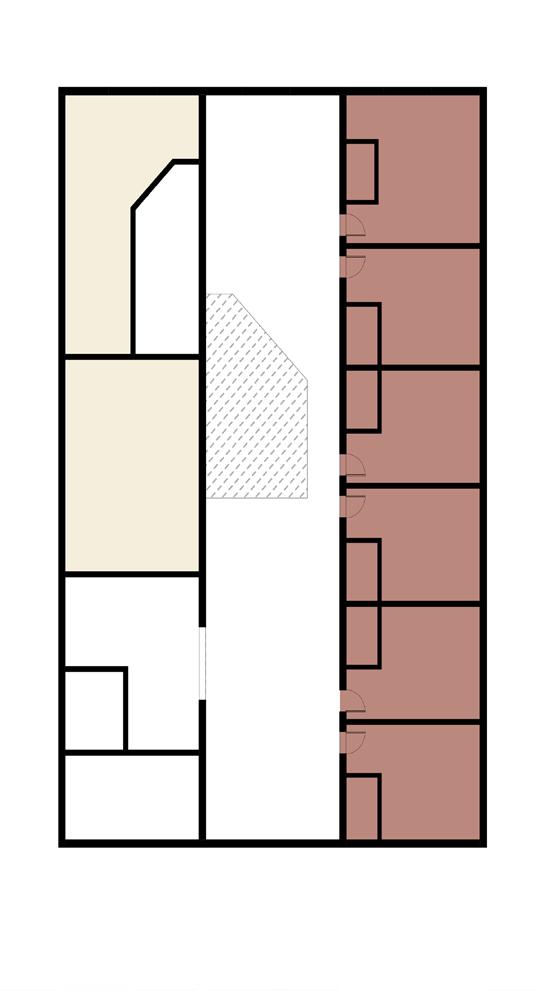
Process 2 Restaurant Lobby M W Guest Room Guest Room Guest Room Guest Room Guest Room Guest Room Elev. Stairs Elev. Stairs Elev. Stairs Stairs Stairs Stairs Guest Room Guest Room Guest Room Guest Room Guest Room Guest Room Ballroom Open to Below Open to Below Conference Conference Fitness Center Process 3 M W Restaurant Lobby Ballroom Guest Room Guest Room Guest Room Guest Room Guest Room Guest Room Guest Room Guest Room Guest Room Guest Room Guest Room Guest Room Elev. Elevator Lobby Elev. Elevator Lobby Elev. Elevator Lobby Stairs Stairs Stairs Stairs Stairs Stairs Open to Below Open to Below Fitness Center Conference Conference
Blocking Diagrams
09
40
FLOOR PLANS


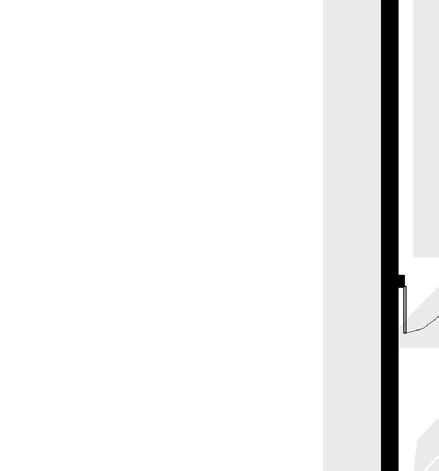
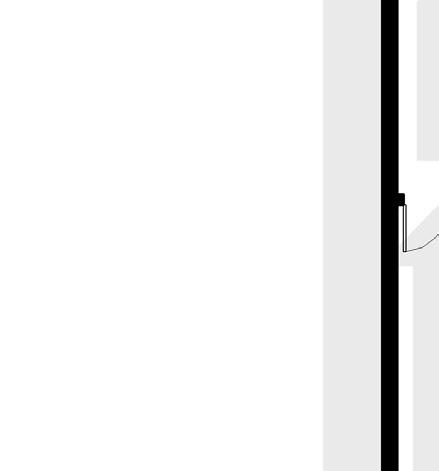









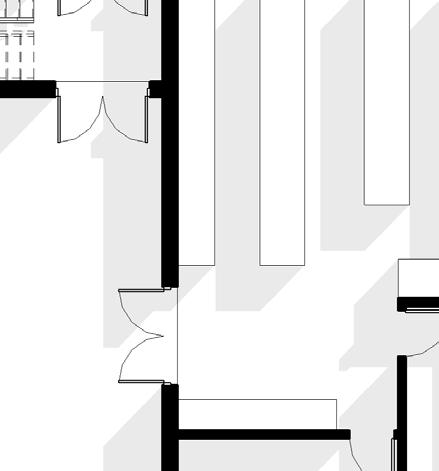
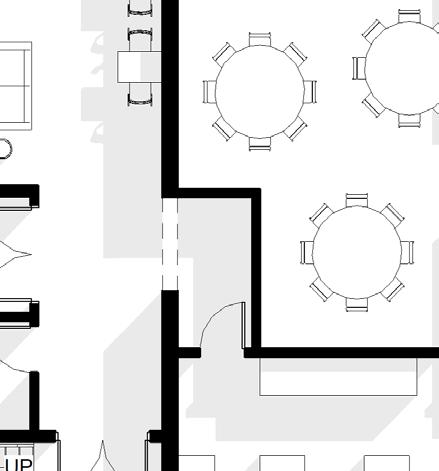

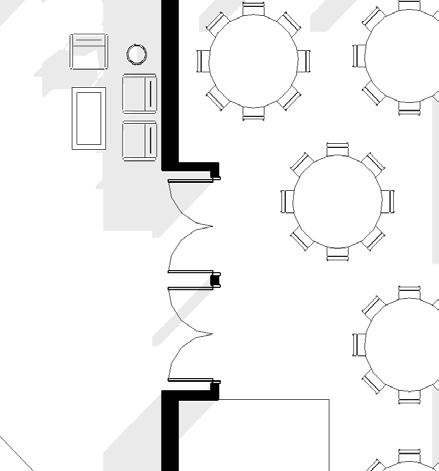


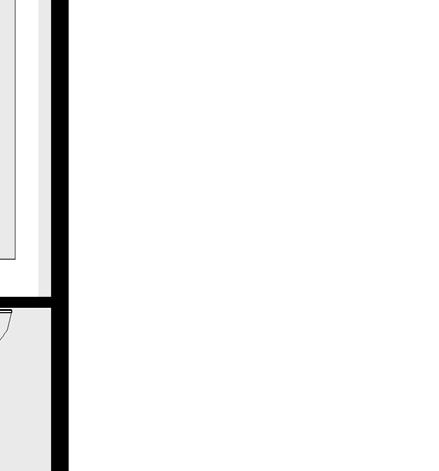

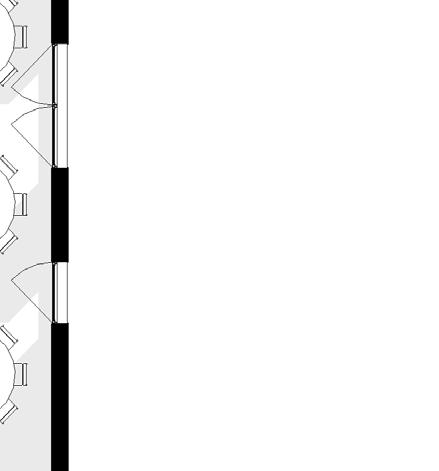
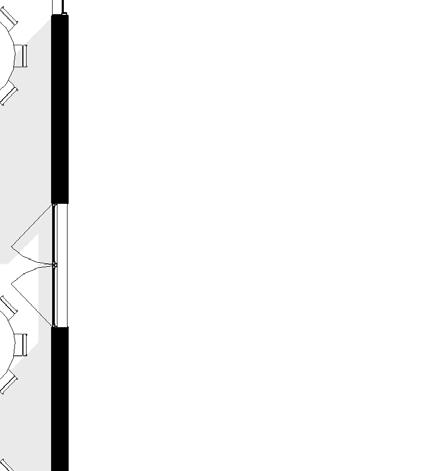

01 Lobby 02 Front Desk 03 Cafe 04 Ballroom 05 Kitchen 06 Luggage Storage 07 Public Restrooms 08 Back of House 09 Employee Restrooms LEGEND 01 02 03 04 05 06 07 08 05 07 09 09 2 2 1 1 41








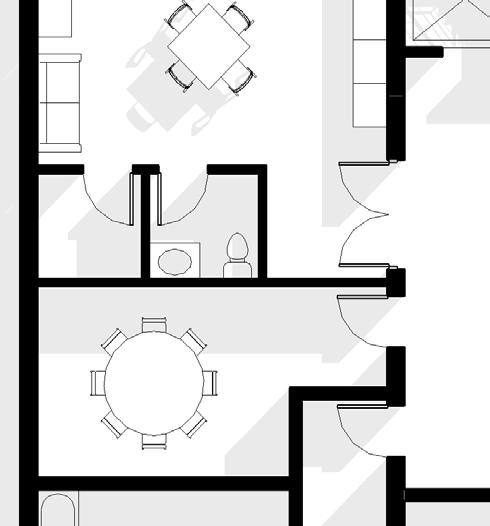




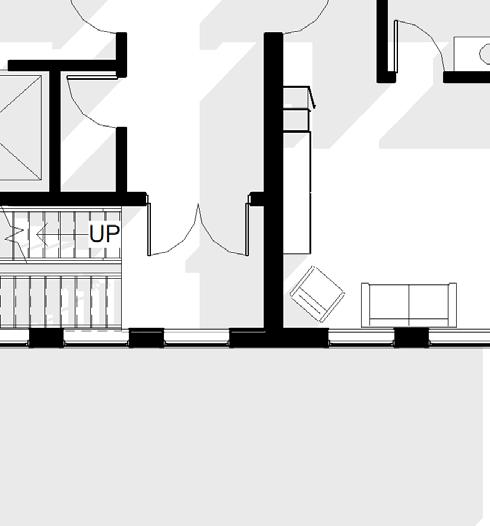
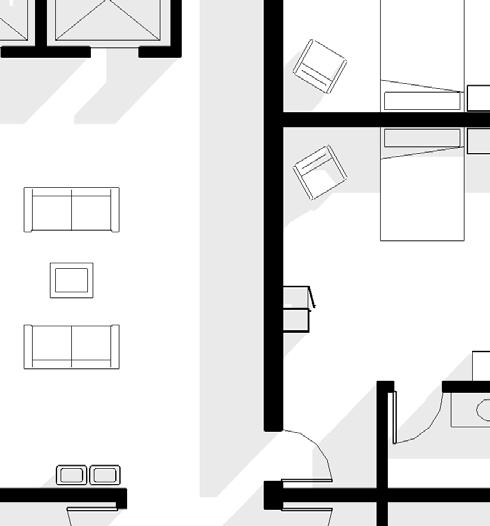







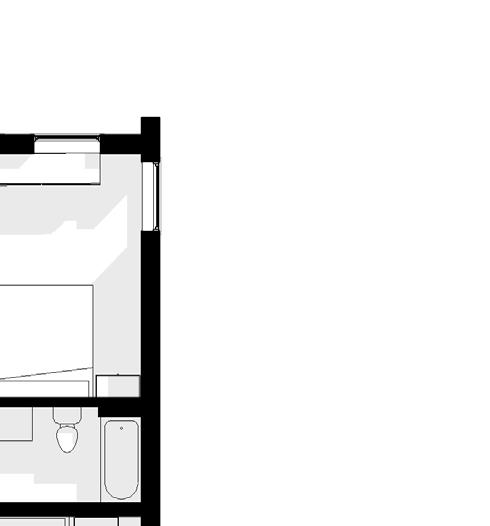

01 01 01 01 01 01 02 02 01 Guest Room 02 Suite 03 Employee Break Room 04 05 Employee Changing Room 06 Conference Room 07 Back of House 08 Storage 09 Open to Below LEGEND 03 04 04 05 06 07 08 09 2 2 1 1 42










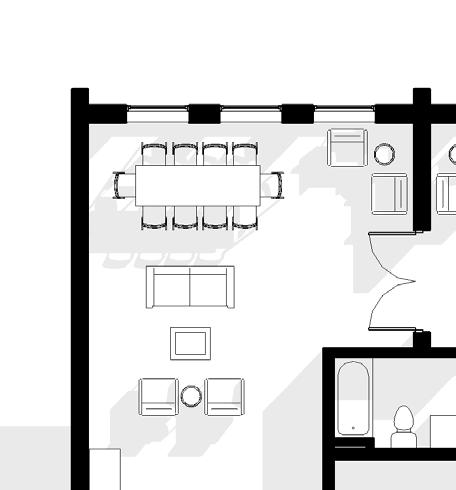





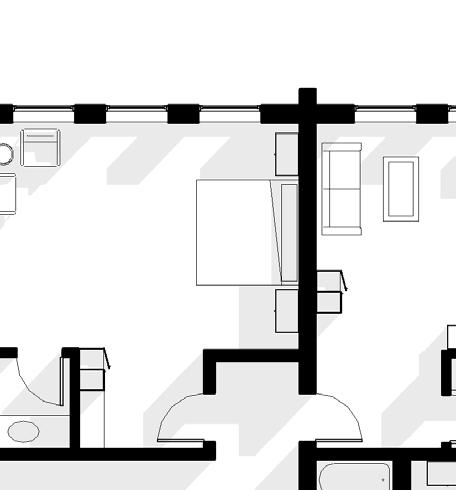


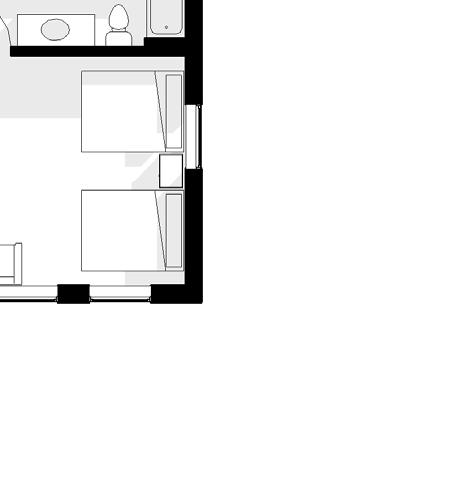


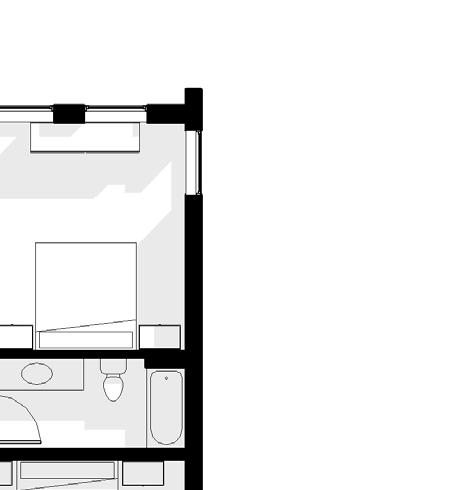

01 01 01 01 01 01 02 02 01 Guest Room 02 Suite 03 Fitness Center 04 Back of House 05 Storage 06 Open to Below LEGEND 04 05 06 03 2 2 1 1 43










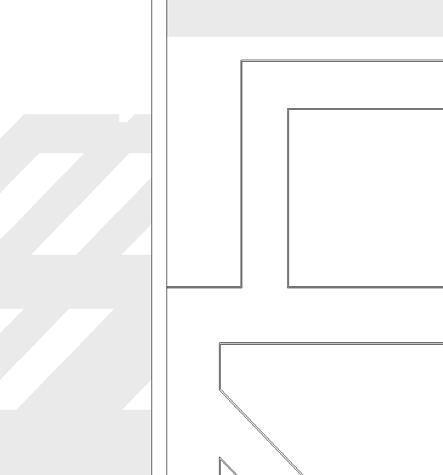




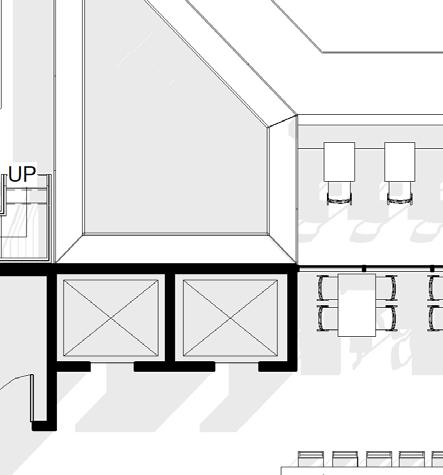



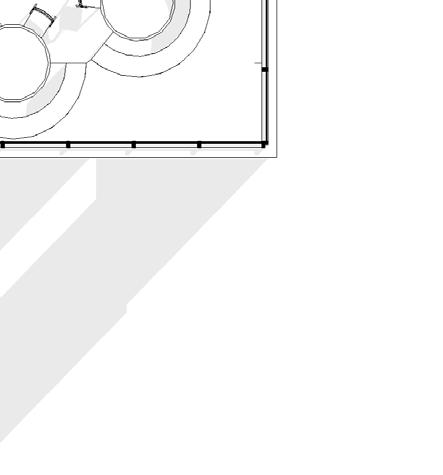

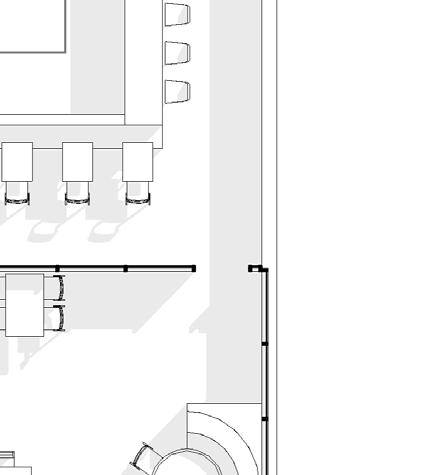


01 Restaurant 02 Rooftop Patio 03 Green Roof 04 Kitchen 05 Restrooms LEGEND 01 02 04 05 03 05 2 2 1 1 44
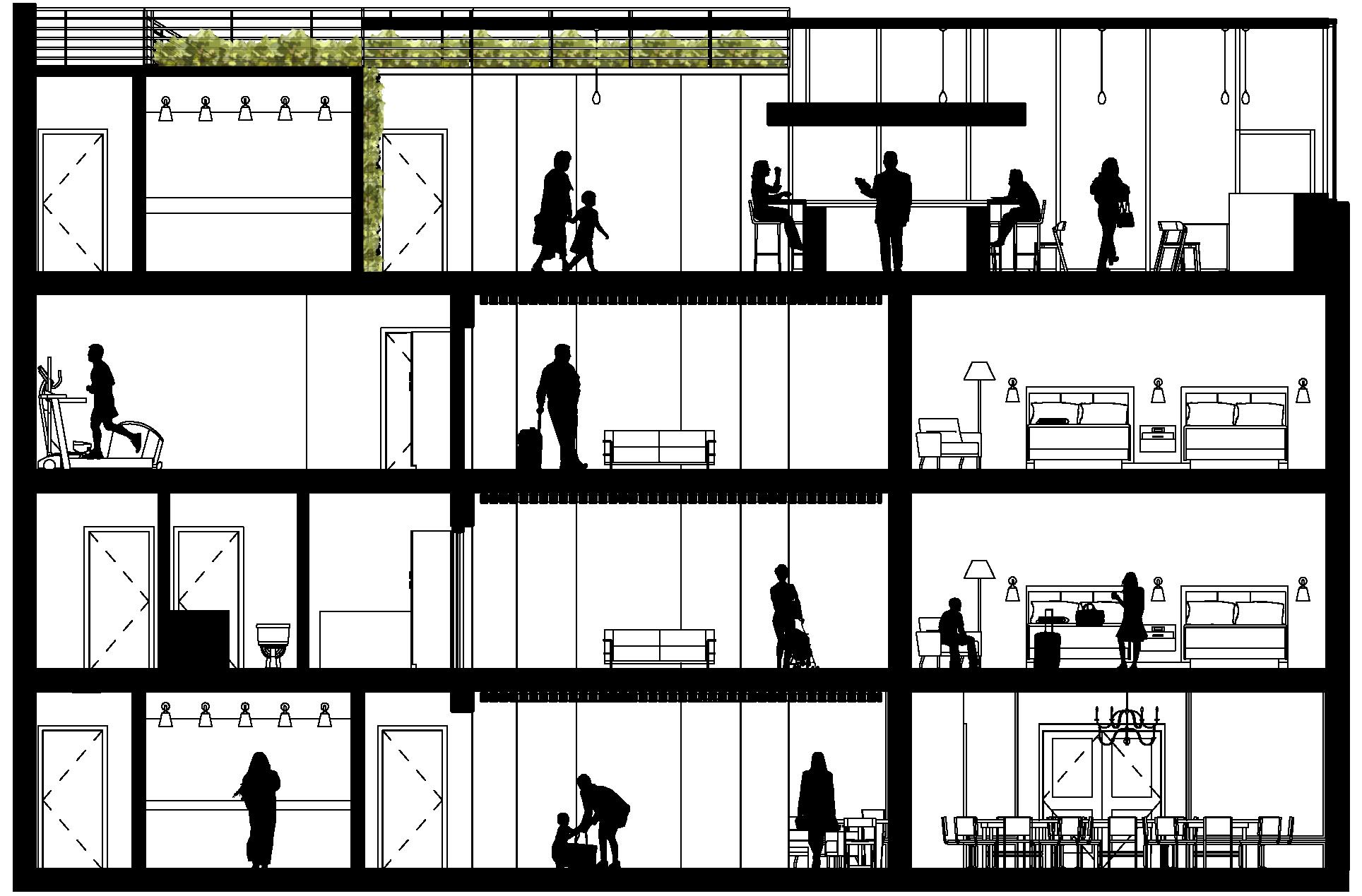

1 2 2 3 4
1
Section
1
reduces energy usage in the rooftop restaurant
11
2
Having guests reuse sheets and towels means less laundry cycles
Energy
3
shower heads and aerators in sinks reduces water consumption
Water
2 Placing recycling bins in the guest rooms provides convenience Soap dispensers replace individual bottles to reduce waste
4
Occupancy sensors turn off lights when room isn’t in use
SUSTAINABILITY
Waste
48
5
The atrium daylighting and reduces energy usage

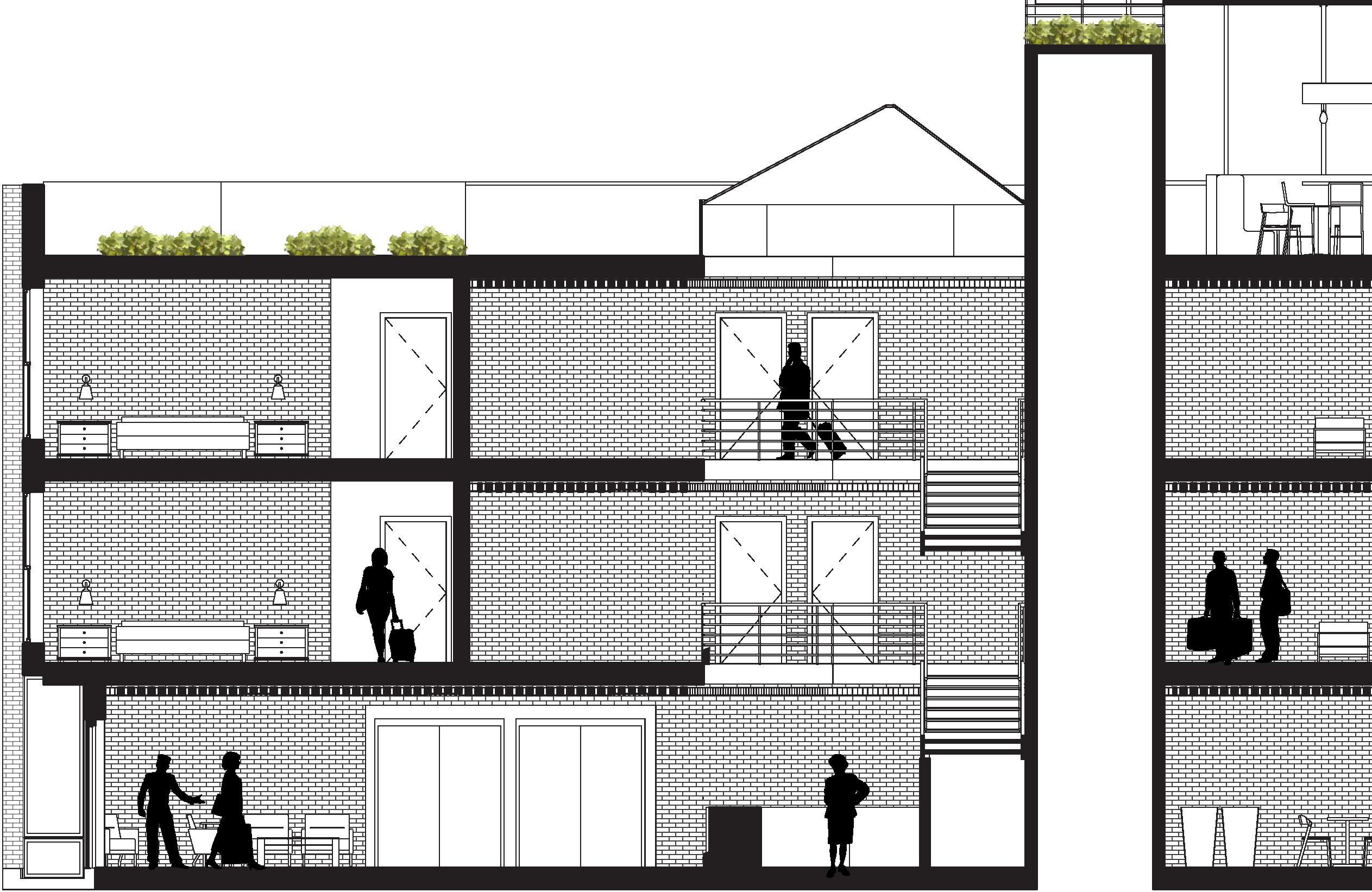
6
Controls water runoff as it is absorbed and the plants
6 7
5
Section 2

6
recycling bins in easy access places promotes recycling by users 7 50
Insulates building from extreme temperature heat gain 6 Placing


12
52
RENDERED PRESPECTIVES







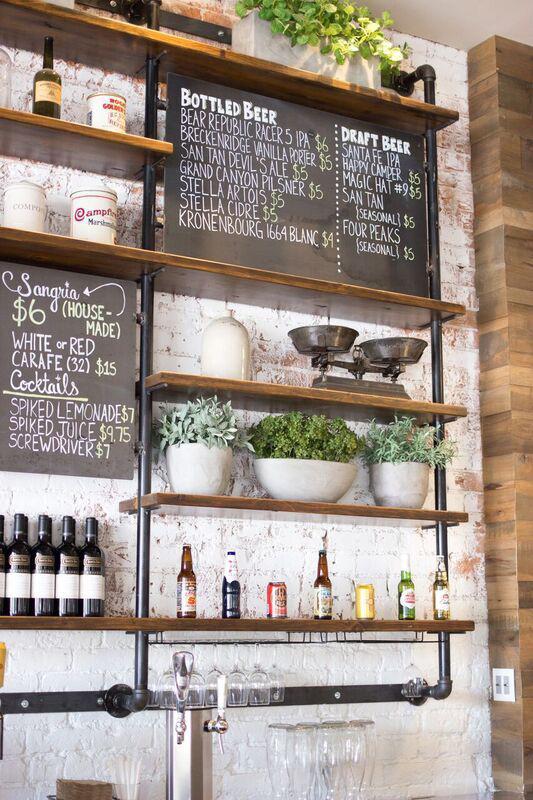




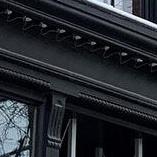

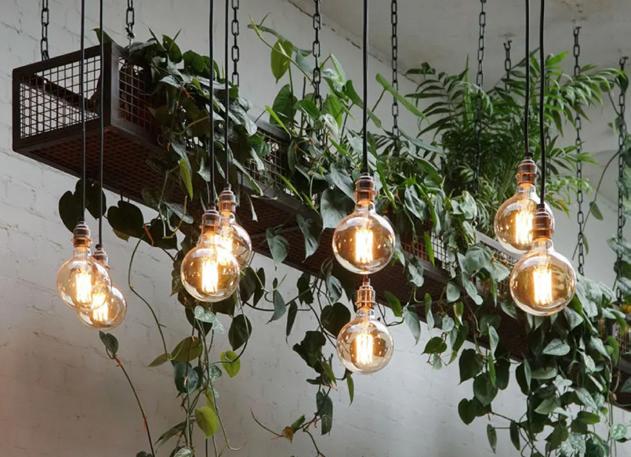

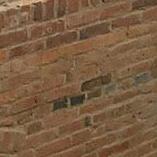
13 MATERIAL AND FURNITURE
60




Rooftop
and Doctoral Dissertations. 556. http://commons.emich.edu/theses/556
https://designbuild.nridigital.com/dbr_hotels_mar19/eco_friendly_design_the_rise_of_ self_sustainability_in_hotels
•
• Ernsting, Andy. “DLR Group’s Interior Design Reinvents Iconic 1915 Blackstone Hotel.” 2020. https://www.dlrgroup.com/about/press-releases/kimpton-cottonwood-hotelopening/
• Gensler Research Institute. “Gensler Experience Index.” 2018. https://www.gensler.com/ research-insight/gensler-research-institute/experience-index
• Gensler Research Institute. “Hospitality Experience Index.” 2018. https://www.gensler.
com/Listing/1001-Farnam-St-Omaha-NE/15875107/
2017. https://www.linkedin.com/pulse/design-guidelines-you-should-know-eco-hotels-
• LeDioyt, Glenn H. “National Register of Historic Places Inventory - Nomination Form.”
project/kimpton-cottonwood-hotel/
• Phelps, Virginia “Proximity is the First LEED Platinum Hotel.” Proximity Hotel. October 2008. https://www.proximityhotel.com/leed_platinum/
• “Sustainable Practices Guide - Proximity Hotel in Greensboro, NC” Proximity Hotel. https://www.proximityhotel.com/sustainable-practices-guide/
•
•
•
•
•
•
• 69





























































































































































